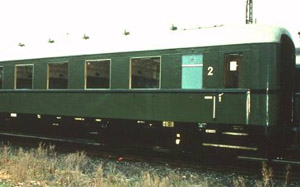| |
Epoch II
Introduction
The rise of the long-distance railroad traffic
A new era, a new generation of coaches
Standard design locomotives
Service on a high level, the Mitropa
The rise of a trainlegend
A new numbering scheme for passenger cars
Beginning of the modern age, electric locomotives
A new idea, the SVT
The competitor of the SVT, the Henschel-Wegmann-Zug
Result of renewal: the Schürzenwagen
The temporarily ending
Result of renewal: the Schürzenwagen
In the thirties the DRG experimented a lot with streamlined rolling stock. While the American railways developed rolling stock for high speeds, like the Zephyr and the Hiawathas, the Germans built fast streamlined steam engines like the BR 03.10 and the BR 05, diesel trainsets like the "Fliegender Hamburger" and trains like the Henschel-Wegmann-Zug.
 | | Second class schürzenwagen |
Based on these experiences the DRG developed the Schürzenwagens or skirted coaches in 1939. Before the skirted coaches, the German coaches were characterised through inwards entrance doors and windows and many equipment installed under the coaches. In 1936 the DRG built six prototypes of the coaches type C4ü-36a. In 1937 the DRG decided that from now on all new passenger coaches must be streamlined like these new skirted coaches. As a result they ordered another five prototypes of these coaches. The production of the skirted coaches began in 1939. The skirted coach was radical different from the other passenger coaches in Germany. The new coaches were streamlined and were entirely welded, what differed in weight. The coaches had roomy entrance compartments and had no more inwards placed doors and windows. The sidewalls on both endsides of the coaches were rounded and were go above a part of the buffers. The roofs of the skirted coaches were characterised by their roundings and their triangular inlets on all four corners. In these inlets there could be placed a signal plate. The braking system and the Görlitz III bogies were designed for speeds of 150 km/h. The skirts on both sides between the bogies, where the coaches owed their nickname to, completed the modern impression of these coaches.
The DRG built 644 skirted coaches until a stop for no more necessary rolling stock stopped the production in 1942. The DRG built also 269 luggage coaches according to the same design. Mitropa took over the design of the skirted coaches, also did the Reichspost. Mitropa built more than 40 dining cars of type WR4ü and 20 sleeping cars of type WL4ü. The Deutsche Reichspost built 568 post coaches of type Post4ü. A small number of coaches was built by foreigner railway companies. The CIWL built 4 sleeping cars according to the design of the skirted coaches. Also the Bulgarian and Turk railway companies built skirted coaches. During the second world war a large number of skirted coaches was destroyed or seriously damaged. After the war the remaining coaches were used by the allied forces for military purposes. All coaches who were standing in West-Germany were handed over to the Deutsche Bundesbahn in 1949.
The following coach types were built between 1938 and 1942 (Skirtedcoaches build between 1938 and 1942 ). More information about these coaches can be found by the skirted coaches and the standard design coaches. ). More information about these coaches can be found by the skirted coaches and the standard design coaches.
|
